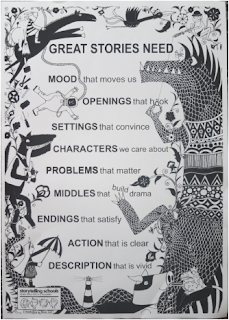We began our year with the usual Teacher Only Days, with a focus on 'Writing' and 'Speaking'...
On 30 Jan 2019 our whole staff attended a professional learning workshop with Sheena Cameron and Louise Dempsey in Hamilton called 'Developing an effective writing programme'.
They shared practical ideas for planning and teaching writing at emergent, early and fluent levels, with reference to ‘The Writing Book’. Workshop aims were to:
They shared practical ideas for planning and teaching writing at emergent, early and fluent levels, with reference to ‘The Writing Book’. Workshop aims were to:
- introduce the key principles of an effective writing programme
- break down the components of a balanced writing programme
- explore the features of both long and short writing lessons
Things mentioned and affirmation:
New ideas / What I've learned:
Goals:
Model and teach students to proofread their writing. Keep it manageable.
Take time to teach students to review and improve their writing with a partner
Resources mentioned:
- The Writing Book
- The Literacy Shed
- The Kid Should See This
On 1 February 2019 we had a professional learning workshop with Lisbeth Swanson from 'StoryWays Literacy' (Storytelling) who visited us at school.
Purpose:
- Consider the language needs of learners (Our school, societal, global)
- Understand the pedagogy of learning and teaching with a storytelling approach
- Learn how to prepare and teach the telling of a story using ‘Hear - Map - Step - Speak’
- Know of the key elements in the Storytelling schools Teaching Model
New ideas / What I've learned:
Things mentioned and affirmation:
- Images are good to use for writing
- Reiterate that punctuation helps a reader to understand what the writer is trying to tell
- Spelling is important (have routines around it e.g. use a word card, listen for sound)
- Make good word choices
- Retelling is a very good first step to writing
- You can keep going with criteria for some time, no need to change it all the time
- No queue waiting for teacher to check, just get them to put their book at designated spot after finishing their story
- Picture plans are good to use in Y1
New ideas / What I've learned:
- Activate kids prior knowledge about writing at start of year. Ask what they remember about writing from previous year
- All kids need guiding during week not just lower kids, but don't overstretched yourself… you can't see everyone
- Roving can be extremely powerful. Students will hear your feedback to others and fix up work
- Don't waste time writing long, big comments in books
- Not everyone will finish, be comfortable with it
- Get kids to self-check / partner-check using stamps afterwards
- To use picture plans further as follow: e.g. one picture = 1 sentence, 2 pictures = 2 sentences, progress but not more than 4 pic (as too time consuming)
- Use different images for kids to write a sentence of each picture
Goals:
Resources mentioned:
- The Writing Book
- The Literacy Shed
- The Kid Should See This
--------------------------------------------------------------------------------------------
Purpose:
- Consider the language needs of learners (Our school, societal, global)
- Understand the pedagogy of learning and teaching with a storytelling approach
- Learn how to prepare and teach the telling of a story using ‘Hear - Map - Step - Speak’
- Know of the key elements in the Storytelling schools Teaching Model
New ideas / What I've learned:
- Use storytelling to motivate, energise and accelerate oral language and writing
- Learning to tell stories from memory is a great way to learn all sorts of essential skills
- Speaking, listening, confidence, empathy, ideas, facts, sequences, plots … you name it, storytelling can teach it.
Goals:
- Tell a story (not just reading) with attention to voice, gesture, feature language
- 'Loiter' with the story - oral language at the center
- Follow-up writing opportunities
~ "Knowledge isn't power until it is applied" - Dale Carnegie ~




No comments:
Post a Comment